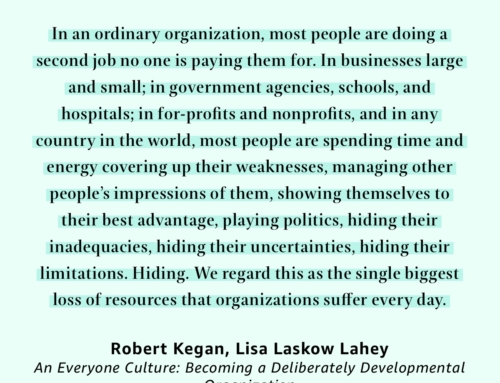LYSSA ADKINSSEPTEMBER 25, 2008
Even in the desert, flowers bloom. So, too, with Agile in a command culture. Amid the rocks and parched soil is a green shoot reaching up that, with a few drops of rain, blooms into a flower.
LEADERSHIP AND CULTURES
One of the best things I ever did was to get my Leadership CultureLink assessment. It’s a read-out on my leadership style and how it relates to the four cultures and four strategies found in corporations. <Commercial on> Michael Spayd is a certified facilitator for this assessment. I highly recommend it. <Commercial off>
This assessment is where I learned about the four corporate cultures and put words to the one I had experienced often in my career: the command culture.
WHAT IS THE COMMAND CULTURE?
Probably many of you have experienced the command culture, so this description from the Corporate Development Group will come as no surprise. Here are some sure-fire signs of a command culture:
- Role Power
- Decision-Making is Methodical, Objective, Cause to Effect
- Work Has Functionalist Emphasis
- Employees Asked to Adhere to Role Requirements
- Structure: Hierarchy
- Teaming Focused on Organizational Goal Attainment
- Key Norms: Certainty, Order, Predictability, Discipline
- Hiring Premised on Fit with Functional Requirements of Job
Hmmm…Doesn’t sound too promising for Agile, where we stress (in fact, rely on) collaboration, creativity, self-organization, empowerment and team-based commitment.
AGILE IN A COMMAND CULTURE
So maybe the Agile that blooms in a command culture isn’t the most lush and beautiful flower in the world. Maybe it’s a little bit prickly, but if you look closely, it’s beautiful, too. A rare beauty.
The same with Agile practices in a command culture. Teams may not use the full set of Agile practices and the organization’s leadership may openly disagree with the principles. They will likely reject the values (such as courage and openness) even as they talk about “empowering” their “people.” Even so, the expression of Agile however limited, can still bring value. And maybe even a little beauty to those practicing it.
Here are a couple of ways Agile helps when working in a command culture.
Scenario: In a command culture, the team is often handed deadlines that a senior manager or project manager created. Agile helps: The short timeframe (the sprint) and transparency of work (the story board) helps teams coordinate to get work done. This helps people stay connected to one another while meeting deadlines. Or, once into it, allows the team to provide specific, grounded feedback about the deadlines, why they’re unrealistic and options for meeting or changing them. In fact, the tactile nature of the story board is a huge benefit. It provides a physical way of explaining why everything can’t get done “on schedule” and allows managers/customers and the team to more explicitly agree because they are moving physical story cards around. Another benefit: it’s harder to have misunderstandings (real or convenient) when using something physical, like a story board.
Scenario: In a command culture, the belief is that all the scope initially envisioned must be completed. Agile helps: Once the team starts producing real things each sprint and showing them to managers/customers, real conversations start to happen. And, when that starts up, managers/customers will likely change their minds about what’s “inside” a deliverable. Don’t expect them to change the deliverable name or drop it all together – remember, predictability and traceability will be important to command culture folks. But, do expect that they will redefine what it takes to get to “done” as the team produces real results and everyone learns more.
And, here’s one thing that will likely not fly in a command culture…
Retrospectives may be viewed as a waste to the managers in a command culture, resulting in the teams (rightfully) feeling like retrospectives are a fraud. In a command culture, managers tell teams not only what to do, but how and when to do it and what the result needs to look like. So, if teams retrospect they may quickly find that their desires to improve are for naught. What I have seen emerge in this situation is the “underground” retrospective. It’s usually an informal talk amongst the team members – part griping, part reality check (they won’t let us do that) and part action (but we can do this). Retrospecting, then, becomes primarily a coping mechanism to help team members stay positive and forward-moving.
STARTING UP AGILE IN A COMMAND CULTURE
There are at least two ways to start Agile in a command culture.
Method 1. Don’t make assumptions about what will and will not work. There is no organization that follows the textbook definition of a command culture to a T. So, use Agile out of the box at first and see what flies and what feels empty. If something feels empty it’s probably because the culture doesn’t support it. As any team would, use the most powerful tool in the Agile arsenal to deal with this: inspect and adapt. After inspecting, drop what feels empty or do the part of it that still works. Be careful when “tailoring” though. To help, here’s a blog post I previously offered regarding tailoring.
Method 2. Stealth practices. Don’t even call what you are doing Agile and use the bare bones of sprints, story boards and a backlog to get a basic level of communication and accomplishment going. From there, you may find that other practices naturally arise, like the manager/customer starting to prioritize the backlog all on their own.
In either case, don’t expect the spectacular results other Agile teams in different cultures achieve. You are fighting with one (maybe two?) hands tied behind your back. So, accept what works and leave behind what doesn’t work or encounters too much resistance.
And, make a habit of frequently stopping to notice the beauty and resilience of the desert flower.





